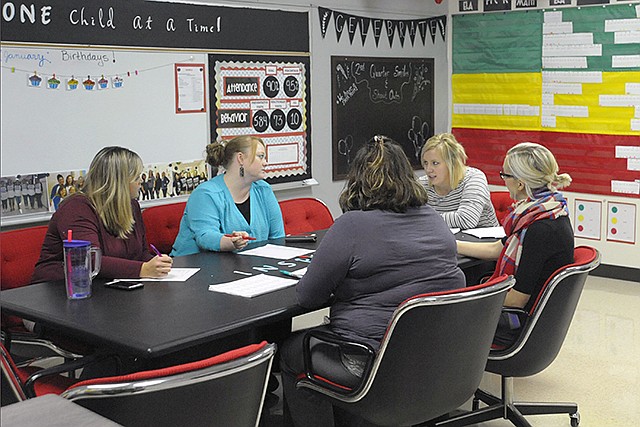Data is helping teachers at California Elementary School know their students better.
Teachers know their students' strengths and weaknesses before they even enter the classroom in August.
Then, throughout the year they have academic data to show trends or deficiencies, which they can compare with other collected information, such as attendance or behavior issues.
"The days of wondering how a student is doing are gone," Principal Gary Baker said. "All the information is there."
In support of the application of this information, the school has cultivated a group approach based on shared leadership.
Instead of the traditional approach, which kept a classroom teacher and his or her students virtually isolated in their own world, California Elementary employees - from cooks and janitors to teachers and administrators - consider each of the 646 students their own.
To support this shift in the learning environment at the elementary school, local businesses - including The Flower Shop, Furniture Factory Outlet and the Missouri Baptist Convention - and the PTO helped convert the old school board room into a data room.
The secure room houses regularly updated student data posted on dry-erase boards, note cards, chalkboards and posters. Inspirational quotes also remind the teachers who meet at the conference table or in the cozy sitting area of their ultimate goals.
The room has some technology capabilities, but the room's data-covered walls are updated regularly by first-grade teacher Susan Hogan and fourth-grade teacher Kelli Williams.
Every two weeks, teachers from each grade level meet in the data room to discuss curriculum strategies and exchange teaching strategies, as well as consider specific students or issues as might arise.
When they are concerned about a particular student, the data room's configuration and immediate access to reports allow them to ask questions and find answers within their limited meeting time.
In the alternating weeks, topic-based teams also use the room to consider more building-wide issues and long-term strategies. Again, having quick access to the data allows the teams to be more efficient and thereby more productive in their time together.
When Hogan and Williams began teaching more than a decade ago, they recalled they didn't share information about the students within their classrooms, though they may have compiled data for their own use.
Both alumni of California schools, Hogan and Williams have been instrumental in the data room development, an outgrowth of the 8-year-old professional learning communities program.
Before that, teachers used paper and pencil to record grades in their red grade book. Today, teachers upload grades online so parents have immediate access to their student's progress.
The pair said they prefer the more collaborative approach, which also has created a better work environment.
"We consider all kids as our kids," Hogan said.
Williams explained although she is responsible for a class of fourth-graders, she has a vested interest in what is happening with second-graders, who will be her future students.
Likewise, Hogan said she enjoys watching the continued growth of former students as they progress through the upper grades.
"I see the growth of kids I had as first-graders," Hogan said. "It's an amazing feeling to see they got it."
The shared data even helps in the special classes, such as music or library, where they can be aware of struggles or weaknesses individual students might have, Hogan noted.
"We want those connections to be there," Williams said.
When possible, they can align projects. For example, when Williams' class was studying biographies, the students made portraits in art class, and the librarian emphasized non-fiction literature.
"It's not complicated," she said.
The data room also provides a mechanism for the teachers to see where students used to be and watch them grow.
That leads to celebrations, a major focus of the record collection process and of Baker and the professional learning communities.
Each group's meeting in the data room takes time not only to note the advancement of students but to write it on the wall for others to see later. Students also receive positive feedback through hallway decorations and other in-class incentives.
The process also shifted some responsibility for tracking grades and individual progress to the students themselves.
"The kids are more self-sufficient, and they have higher expectations for themselves," Williams said. "They are proud, and they love to know what they know.
"It's taken grades from a negative to a positive."
Hogan and Williams also are proud other Missouri schools now are coming to observe what's working at California Elementary School.
"When we saw the whole picture come together and looked at what we've done, it's pretty cool," Williams said. "We're making sure your child gets every bit of the education available. Our practices are powerful."
The new approach is designed to ensure students have a "true understanding of concepts," not simply regurgitated facts on demand, Baker said.
"We have seen gigantic educational leaps in short amounts of time," he said. "Daily, we have amazing things happening."
Although the data informs instruction, Williams emphasized they are teachers first.
"We teach and have fun and take care of the data later," she said. "Data is important, but it's not everything."
Link:

